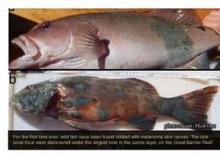Riddle me this: How is a fish like a canary?
As you know, miners used canaries underground, where they functioned as warning systems – when toxic gases leaked into the shaft, the birds would die, signaling a need for the minors to leave the shaft.
Today, it seems prudent to heed the plight of the Great Barrier Reef coral trout, Plectropomus leopardus.
According to Dr. Michael Sweet, a marine research associate at Newcastle (Australia) University, 15% of coral trout caught in two reef locations in Australia were found to have skin cancer. This is the first report of melanoma occurring in a wild fish population, he noted.
Coral trout are a valuable food and sport fish that live at a depth of up to 30 m in unpolluted, clear water – well within the 60-m reach of Australia’s strong UVB radiation, wrote Dr. Sweet.
Several decades ago, there was no problem. But today, a hovering ozone hole seems to have compromised the fish’s health, he noted.
After he heard of coral trout with dark skin lesions, Dr. Sweet went reef fishing. He and his colleagues pulled in 136; 20 of the fish showed visible skin lesions that were raised and darkly pigmented. He took samples from each fish and tested them for microbial, fungal, and parasitic infections (PLoS ONE 2012 Aug. 1 [doi: 10.1371/journal.pone.0041989])
The fish had no infections or disease. But, histologically, they showed disorganized pleomorphic cells, melanocytes, epithelioid-like cells, melanophores, and macromelanophore cells, consistent with lesions induced in a fish cancer model.
The fishes’ behavior seemed unaffected, and all the lesions appeared to be stage I or II. But that isn’t necessarily reassuring, Dr. Sweet reported. Fish exhibiting stage III, IV, or V cancers may show behavioral differences in the wild and may, therefore, have not been caught.
So – other than a general concern for the health of the Great Barrier Reef – why should we care about wild fish developing melanoma?
Jen Makin, a research and evaluation manager for Australia’s SunSmart program, cited unsettling figures about the Australian UV situation and skin cancer (Health Promot. J. Austr. 2011;22:S39-41).
"It is estimated that nearly 450,000 Australians get skin cancer every year," she wrote – 95% of the cancers are directly related to UV radiation.
The ozone layer is slowly recovering its health, but an ever-hotter Earth may undo that skin-protecting change. "Before recovery, it is expected that higher levels of UV radiation will continue in most Australian regions, with an associated higher risk of skin cancer. Indeed, recent data show increases in surface UV radiation throughout Australia since the 1970s. Second, mean temperatures in Australia have increased over the past 30 years and are projected to rise further by 2030," she wrote.
In hot weather, adults spend more time outdoors, are less likely to cover up, and are more likely to get burned. And – as the coral trout have proved – there seem to be few places to hide.
–Michele Sullivan (on Twitter @Alz_Gal)


